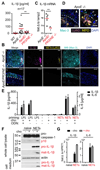Inflammation. Neutrophil extracellular traps license macrophages for cytokine production in atherosclerosis
- PMID: 26185250
- PMCID: PMC4854322
- DOI: 10.1126/science.aaa8064
Inflammation. Neutrophil extracellular traps license macrophages for cytokine production in atherosclerosis
Abstract
Secretion of the cytokine interleukin-1β (IL-1β) by macrophages, a major driver of pathogenesis in atherosclerosis, requires two steps: Priming signals promote transcription of immature IL-1β, and then endogenous "danger" signals activate innate immune signaling complexes called inflammasomes to process IL-1β for secretion. Although cholesterol crystals are known to act as danger signals in atherosclerosis, what primes IL-1β transcription remains elusive. Using a murine model of atherosclerosis, we found that cholesterol crystals acted both as priming and danger signals for IL-1β production. Cholesterol crystals triggered neutrophils to release neutrophil extracellular traps (NETs). NETs primed macrophages for cytokine release, activating T helper 17 (TH17) cells that amplify immune cell recruitment in atherosclerotic plaques. Therefore, danger signals may drive sterile inflammation, such as that seen in atherosclerosis, through their interactions with neutrophils.
Copyright © 2015, American Association for the Advancement of Science.
Figures




Comment in
-
Immunology. Neutrophil-macrophage communication in inflammation and atherosclerosis.Science. 2015 Jul 17;349(6245):237-8. doi: 10.1126/science.aac7801. Science. 2015. PMID: 26185231 No abstract available.
-
Inflammation: NETting a one-two punch.Nat Rev Immunol. 2015 Sep 15;15(9):526-7. doi: 10.1038/nri3898. Epub 2015 Jul 31. Nat Rev Immunol. 2015. PMID: 26228903 No abstract available.
References
-
- Swirski FK, Pittet MJ, Kircher MF, Aikawa E, Jaffer FA, Libby P, Weissleder R. Monocyte accumulation in mouse atherogenesis is progressive and proportional to extent of disease. Proc Natl Acad Sci U S A. 2006;103:10340–10345. doi: 10.1073/pnas.0604260103. published online EpubJul 5. - DOI - PMC - PubMed
Publication types
MeSH terms
Substances
Grants and funding
LinkOut - more resources
Full Text Sources
Other Literature Sources
Medical
Molecular Biology Databases

